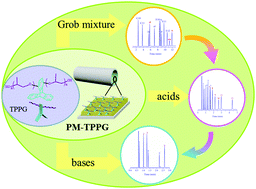A novel column modification approach for capillary gas chromatography: combination with a triptycene-based stationary phase achieves high separation performance and inertness†
Abstract
This work presents a novel strategy for the construction of a capillary column with high resolving performance and inertness for gas chromatographic (GC) analysis by combining the proposed surface modification with a selective stationary phase. Through the modified biphasic sol–gel reaction inside a capillary GC column, porous modification was made on the capillary surface (PM capillary) prior to coating with a stationary phase. Herein, we designed and synthesized a new triptycene-based stationary phase (TPPG) for the study. Using the proposed strategy, the PM-TPPG column was fabricated with a column efficiency of 4950 plates per m determined by n-dodecane at 120 °C and then investigated for its separation performance, inertness, repeatability, loadability and thermal stability. As demonstrated, the PM-TPPG column showed distinct advantages in these aspects over two reference columns (TPPG column and commercial PEG column). Particularly, the PM-TPPG column well resolved all the components in the Grob mixture and exhibited distinctly improved peak shapes for carboxylic acids and heterocyclic bases. Moreover, it exhibited excellent repeatability and reproducibility and higher column loadability than the two reference columns. Its applications to purity monitoring of chemical products demonstrate its good potential for practical GC analysis.



 Please wait while we load your content...
Please wait while we load your content...